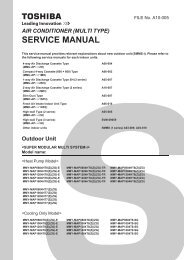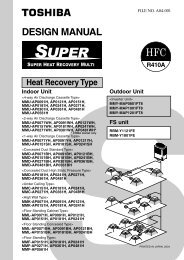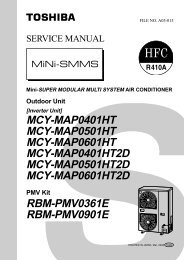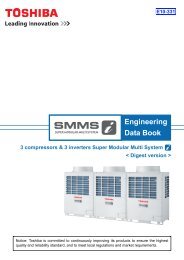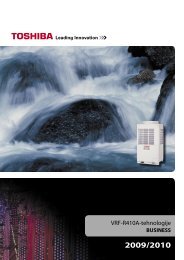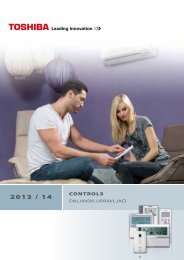SERVICE MANUAL - Toshiba
SERVICE MANUAL - Toshiba
SERVICE MANUAL - Toshiba
You also want an ePaper? Increase the reach of your titles
YUMPU automatically turns print PDFs into web optimized ePapers that Google loves.
e.g., chargedamount (10kg)WARNINGS ON REFRIGERANT LEAKAGECheck of Concentration LimitThe room in which the air conditioner is to beinstalled requires a design that in the event ofrefrigerant gas leaking out, its concentration willnot exceed a set limit.The refrigerant R410A which is used in the airconditioner is safe, without the toxicity orcombustibility of ammonia, and is not restricted bylaws to be imposed which protect the ozone layer.However, since it contains more than air, it poses therisk of suffocation if its concentration should riseexcessively. Suffocation from leakage of R410A isalmost non-existent. With the recent increase in thenumber of high concentration buildings, however, theinstallation of multi air conditioner systems is on theincrease because of the need for effective use of floorspace, individual control, energy conservation bycurtailing heat and carrying power etc.Most importantly, the multi air conditioner system isable to replenish a large amount of refrigerantcompared with conventional individual air conditioners.If a single unit of the multi conditioner system is to beinstalled in a small room, select a suitable model andinstallation procedure so that if the refrigerantaccidentally leaks out, its concentration does notreach the limit (and in the event of an emergency,measures can be made before injury can occur).In a room where the concentration may exceed thelimit, create an opening with adjacent rooms, or installmechanical ventilation combined with a gas leakdetection device.The concentration is as given below.Total amount of refrigerant (kg)Min. volume of the indoor unit installed room (m³)≤ Concentration limit (kg/m³)The concentration limit of R410A which is used in multiair conditioners is 0.3kg/m³.NOTE 1 :If there are 2 or more refrigerating systems in a singlerefrigerating device, the amounts of refrigerant shouldbe as charged in each independent device.Outdoor unite.g.,charged amount (15kg)Room A Room B Room C Room D Room E Room FIndoor unitFor the amount of charge in this example:The possible amount of leaked refrigerant gas inrooms A, B and C is 10kg.The possible amount of leaked refrigerant gas inrooms D, E and F is 15kg.NOTE 2 :The standards for minimum room volume are asfollows.(1) No partition (shaded portion)(2) When there is an effective opening with theadjacent room for ventilation of leaking refrigerantgas (opening without a door, or an opening 0.15%or larger than the respective floor spaces at thetop or bottom of the door).Outdoor unitRefrigerant pipingIndoor unit(3) If an indoor unit is installed in each partitionedroom and the refrigerant tubing is interconnected,the smallest room of course becomes the object.But when a mechanical ventilation is installedinterlocked with a gas leakage detector in thesmallest room where the density limit is exceeded,the volume of the next smallest room becomes theobject.Refrigerant pipingVerysmallroomSmallroomMediumroomLarge roomMechanical ventilation device - Gas leak detectorOutdoor unitIndoor unitNOTE 3 :The minimum indoor floor area compared with theamount of refrigerant is roughly as follows:(When the ceiling is 2.7m high)40m² 35Min. indoor floor area302520151050ImportantRange below thedensity limitof 0.3 kg/m³(countermeasuresnot needed)Range abovethe density limitof 0.3 kg/m³(countermeasuresneeded)10 20 30Total amount of refrigerantkg



